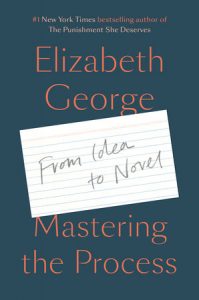
My Writing Schedule is for Satisfaction, Not Fun
A No-Frills Look at Elizabeth George's Routine
Sometimes people are curious about how a writer schedules her day in order to get her writing done, and this brief chapter will show you how this one writer does it. I would love to have nothing else to do but my writing, but that isn’t the case for me and it’s probably not the case for you either. The question is, how does someone get anything done when there are endless calls upon one’s time?
This is how I do it: I work to a daily schedule, and it’s a simple one. Alarm goes off at 4:50 a.m., and I attempt to drag myself out of bed.
Sometimes I manage it at once. Other times I just can’t manage it. But in either case, I eventually put on my workout clothes and ride the Exercycle, then do weight training.
Showered, dressed, and otherwise looking presentable, I head with my dog to my office, which is about a ten-minute drive from my house. Once there, as I’m eating breakfast, I draw up my schedule for the day. This will include my writing, a period of studying Italian, dealing with email, dealing with snail mail, running errands, and going to appointments.
My schedule is arranged so that I can do my writing in the morning. Depending on what part of the process I’m dealing with, I either write to a specific page count (five pages a day when I’m doing the rough draft; fifty pages a day when I’m doing the second draft), I write to a particular objective (two character analyses or ten step-outlined scenes or two running-plot-outlined scenes), or I write to a timer.
In advance of anything else I do on the trip, I do my writing, generally quite early in the morning.
Sometimes what I’m doing is organizational work prior to the writing process: organizing all my photographs, reading research that I’ve pulled off the Internet, looking for books on a topic that will be handled in the novel, creating a particular setting (such as the boarding school in Well-Schooled in Murder or St. Stephen’s College at Cambridge University in For the Sake of Elena). But in any case, I keep my commitment to the schedule and get that work done.
I take very few breaks, mostly because I’m writing in an isolated and largely silent location. I might get up and walk around; I might go outside onto the balcony and look at the view; on rare occasions I might walk down to the local coffeehouse and have a latte.
If I travel to another location, my writing goes with me. In advance of anything else I do on the trip, I do my writing, generally quite early in the morning. For the length of time that I’m writing an individual novel, I write five days a week. I take weekends off. I also take off the Fourth of July, Thanksgiving Day, and Christmas Day.
Weekends are a time to spend with my husband, to relax, to read, to see friends, to go out to dinner, to go to the theater or to concerts, to have adventures, to try out new activities, to explore the Pacific Northwest, to take the dog to dog parks or to other spots she’ll enjoy.
Following this schedule, I end up writing a novel.
Someone I used to teach with once said to me rather sneeringly, “Well, that doesn’t sound like fun,” when I explained to him what my writing life was like.
I responded by saying that skiing is fun, riding roller coasters is fun, boogie boarding is fun, shopping with girlfriends is fun . . . but I don’t require my career to be fun. I require it to be challenging and deeply satisfying. For me, fun is ephemeral. Satisfaction generally is not.
__________________________________

From Mastering the Process by Elizabeth George, published by Viking, an imprint of Penguin Publishing Group, a division of Penguin Random House, LLC. Copyright © 2020 by Susan Elizabeth George.
Elizabeth George
Elizabeth George is the New York Times bestselling author of twenty psychological suspense novels, four young adult novels, one book of nonfiction, and two short-story collections. Her work has been honored with the Anthony and Agatha awards, two Edgar nominations, and both France’s and Germany’s first prize for crime fiction, as well as several other prestigious prizes. She lives in Washington State.



















